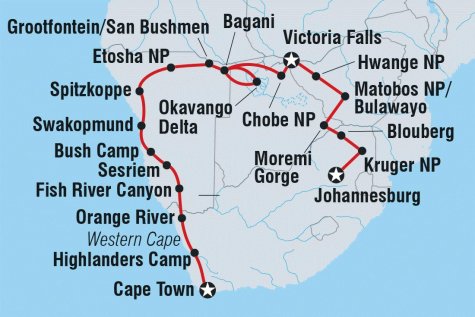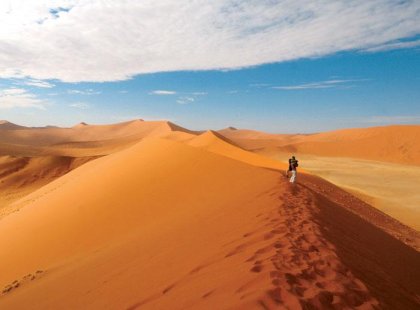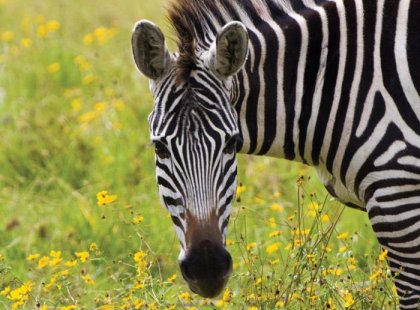Southern Africa Adventure
30 days
From
$ 4455
Duration30 days
Enjoy a African adventure from South Africa through Namibia, Botswana and Zimbabwe. Get set for an adventure packed with majestic wildlife, remote desert landscapes and natural wonders. From the stunning beauty of Cape Town, to a burnt orange sunset over Namibia's Fish River Canyon, to a river cruise through Chobe National Park and the famous Kruger National Park - this ultimate Africa tour will create memories to last a lifetime. Canoe down the Okavango Delta in Botswana, embark on a game drive in Etosha National Park and feel the raw power of Victoria Falls on this journey filled with the very best of southern Africa.
-
Duration: 30 daysService level: Basic
-
Physical Grading: Light
-
Ages: 15+

Itinerary
Day 1: Cape Town
Sawubona! Welcome to South Africa. With its stunning coastline, modern cityscape and nearby mountains, Cape Town is one of Africa's most exciting cities. Your adventure begins with a welcome meeting at 6pm on Day 1. You can arrive at any time as there are no activities planned until this important meeting. Please ask the hotel reception where it will take place. If you can't arrange a flight that will arrive in time, consider arriving a day early so you are able to attend. If you are going to be late, please inform the hotel reception. We'll be collecting your insurance details and next of kin information at this meeting, so please ensure you have these to provide to your leader.
Day 2: Western Cape
Leaving Cape Town behind, travel up the Western Cape (approximately 6 hours). Sit back, relax and enjoy the sprawling scenery. Tonight you will stay on a working farm. This is a great chance to gain an insight into everyday life in this remote part of South Africa. Your camp tonight has shared facilities and upgrades are possible (subject to availability).
Meals: B, D
Day 3: Orange River
Journey to the Orange River, the beautiful natural border between South Africa and Namibia (approximately 9 hours). En route you will pass through Namaqualand, which is famous for its wildflowers that spring up from late July to mid September. Traditionally known as the Gariep River, the Orange River is the longest in South Africa (2200 km). Its source is high up in the Drakensberg mountain range in Lesotho, and it flows into the Atlantic Ocean at Alexander Bay in South Africa. Your camp tonight has shared facilities and optional upgrades.
Meals: B, D
Day 4: Fish River Canyon
This morning there is the chance for an optional canoe adventure on the Orange River. Floating leisurely down the stream is a great way to discover the beauty of this region. Head further west into the desert lands of Namibia towards Fish River Canyon (approximately 4–5 hours). At 500 metres deep and over 160 km long, Fish River Canyon is one of the largest canyons in the world. At any time of year there are remarkable photographic opportunities here as we watch the color of the granite rocks change as the sun goes down. The camp tonight is equipped with showers and flush toilets.
Meals: B, L, D
Day 5: Sesriem
Today's drive, toward the fabled dunes of Namibia, is quite long (approximately 10 hours). You will have the opportunity to stop at a market or shop to stock up on supplies before tomorrow's bush camp. Upon arrival, stretch your legs and take in the exciting desertscape. You will be situated in the most famous part of the Namib Desert, among the vast dune fields, the most spectacular of which are found near the Sesriem Canyon. Get an early night in preparation for your dawn hike tomorrow. Your camp has shared facilities, and no upgrades or WiFi are available.
Meals: B, L, D
Day 6: Sossusvlei / Bush Camp
Wake up before dawn and scramble to the top of the dunes for a dramatic sunrise view across a vast sea of sand. The colour changes are simply incredible and provide a spectacular setting for your brunch. The dunes are stunning, with magnificent red/orange tones from the brightly coloured sands. They are the highest in the world and home to a plethora of animal life. Afterwards you will jump in the back of a pickup truck for a trip to Sossusvlei, the incredible salt and clay pan just nearby (approximately 30 minutes each way). You'll have plenty of time to explore this mysterious desert oddity. In the afternoon, drive to your bush camp in the heart of the Namib Desert (approximately 4 hours).
Meals: B, L, D
Day 7: Swakopmund
Continue to Swakopmund (approximately 4 hours). Surrounded by the massive dune fields of the Namib Desert on three sides and the Atlantic Ocean on the other, Swakopmund is an ideal place for outdoor activities. The township has an interesting German-Namibian atmosphere, which makes it a pleasant town to simply walk around and explore. Your accommodation here is a cosy desert bungalow. Each of these bungalows sleeps six people, and bathroom facilities will be shared. WiFi is available.
Meals: B, L
Day 8: Swakopmund
With free time today, it's worth checking out the Germanic architecture and taking advantage of some excellent souvenir shopping. If you're after a dose of history and culture, you can stop in at the lighthouse and visit the Swakopmund Museum. Active types and thrill-seekers might like to take advantage of the many outdoor activities on offer – this town is the adventure-sports mecca of Namibia. (It's important to check with your leader if you are unsure about the safety of any of these options, as some may not be recommended by Intrepid.)
Day 9: Swakopmund
With another free day in this beautiful seaside town, you might like to do some reading, relaxing and swimming. Alternatively you can venture further afield – perhaps to the Okakambe Trails or the Camel Farm (both located in the same area, around 12 kilometres east of town). A horse ride or camel ride is a great way to see the desert from a different perspective.
Day 10: Spitzkoppe
Travel to Spitzkoppe (approximately 6 hours). Experience the sight, sound and smell of thousands of olive-coloured seals on the shores of Cape Cross while travelling up the Atlantic Coast. Visit one of the most stunning areas of Namibia, the wild lands around the mountain of Spitzkoppe – 'the Matterhorn of Namibia'. Although you shouldn't try to climb to the top, there are some excellent hikes and guided walks throughout the area, which is rich in plant life and even has some bush paintings to be found. Be sure to look out for the sunset from your bush camp this evening – the landscape is known to take on dazzling oranges and reds.
Meals: B, L, D
Day 11: Etosha National Park
Travel to Etosha National Park (approximately 9 hours), stopping at a market or shop and ATM if required. Etosha is among the world's premier places to view wildlife. A wide range of Southern Africa's wildlife roams here, including all the big carnivores and the five rare or endangered species: black rhino, Hartmann's mountain zebra, black-faced impala, roan antelope and the tiny Damara dik-dik. Tonight there is an option to take an evening game drive in the park before spending the night at the particularly spectacular Okaukuejo Camp. The camp overlooks a floodlit waterhole visited by many different species throughout the day and night. Note that upgrades are not available at tonight's accommodation.
Meals: B, L, D
Day 12: Etosha National Park
Enjoy a full-day game drive in Etosha National Park. Game viewing in the park is relatively easy due to the man-made waterholes and the large, sparsely vegetated pans. The bushland surrounding the pans is difficult to see through, but there are enough clearings, pans and waterholes to usually allow for some sightings. Namibia has protected its game reserves against poaching, which means significant numbers of elephants, antelope and other herbivores reside here. This evening you will spend the night at Namutoni Camp (upgrades are available, subject to availability).
Meals: B, L, D
Day 13: Grootfontein/San people
Continue to your next camp which is located 50km outside Grootfontein (approximately 5 hours). This will be your base for visiting the San people tomorrow. Arrive at your camp, stretch your legs, perhaps enjoy a cool drink and kick back with your fellow travellers. There is the possibility of an upgrade, but wi-fi is not available.
Meals: B, D
Day 14: Grootfontein
Embark on a 180-kilometre round-trip to visit the San people. You will go out walking with some of the tribe, listening to their stories and songs. You'll soon discover that they communicate in a unique and fascinating Khoisan dialect, commonly known as a 'clicking' language. The San are the oldest ethnic group in Namibia, having inhabited Southern Africa for an estimated 20,000 years. Around 30,000 of them live in Namibia, but only 2,000 of them still follow a traditional way of life. The San have a deep understanding of nature and ecology, living in harmony with their environment.
Meals: B, L, D
Day 15: Bagani
Head to Bagani, where you will set up camp for the night. Bagani is a small, friendly town with some good hiking trails along the river and plenty of nice spots in which to relax and soak up the ambience. This area is the homestead of the local Mbukushu kings. Your camp tonight has flush toilets, showers, WiFi and optional upgrades.
Meals: B, D
Day 16: Okavango Delta
Drive across the border into Botswana and head south along the Okavango Panhandle (the narrowest part of the delta) to Seronga. Here you'll leave your vehicle and join your transport for the journey into the delta (approximately 4 hours). Boarding boats out into the swamps, travel to Gao Island to meet your mokoro team and start exploring the Okavango Delta with them. Each mokoro (small dugout canoe) takes two people and is poled along through the meandering waterways by a local tribesman. Punting along past birds and lily pads, you'll hear hippos occasionally piercing the peaceful atmosphere with their charming grunts. On the first night here you'll camp on an island away from civilisation (with no WiFi or upgrades available).
Meals: B, L, D
Day 17: Okavango Delta
Continue your trip around the delta and then return to Gao Island before heading to the relative civilisation of Umvuvu Camp with its (usually) hot showers and small bar. Today there is an option to take a nature walk with your guide. This is a great chance to discover the beautiful natural surrounds, gain some insight into the history of the local area and take some photos.
Meals: B, L, D
Day 18: Bagani
Return to Bagani for the night. There will be time to relax, or to take part in one of the many activities on offer. Bagani offers a range of boat trips and fishing excursions. There are also many excellent hiking trails to explore. Ask your leader about how to take up one of these options. Your camp has flush toilets, showers and WiFi. Upgrades are available (subject to availability).
Meals: B, L, D
Day 19: Chobe National Park
From Bagani you will embark on quite a long drive (approximately 8 hours). But your destination, the incredible Chobe National Park, will be well worth it! Enter Botswana at Goma border, which is also the gateway to the park. Take an optional cruise down the Chobe River – one of the best ways to witness some of the park's many animals. Your camp is located outside of Chobe National Park and has flush toilets, showers, WiFi and an ATM. Upgrades are available (subject to availability).
Meals: B, D
Day 20: Chobe National Park
Enjoy an early-morning game drive. Adventuring through the park, you will have the opportunity to get up close to the wildlife. With some luck you will spot a variety of creatures – lions, buffaloes and any number of exotic birds. Botswana's first national park is famous for its high concentration of elephants, so keep an eye out for them. They can often be seen swimming in the Chobe River. The river also attracts chettahs, hippos and crocodiles; the latter like to sun themselves by the water's edge. In the afternoon perhaps take an optional boat cruise to gain a different view of these amazing animals.
Meals: B, L, D
Day 21: Victoria Falls
Travel on to Victoria Falls (approximately 3 hours), crossing the border into Zimbabwe in time to have lunch on the banks of the Zambezi. Though a visit to Victoria Falls' is optional, it is highly recommended. The staggering curtain of water is about 1.6 kilometres, and cascades 108 metres into a narrow gorge below. In the wet season, the spray created can rise up an incredible 400 metres and the falls become an impressive raging torrent. In the dry season, the view of the falls is unobstructed by spray and you can see little islets in the river below. The Victoria Falls entrance fee is not included in the price of the trip, as it is mandatory for tour groups to have a local guide escort. We feel that seeing these waterfalls for the first time should be an uninterrupted sensory experience. Your leader will take you to a local activity centre where a range of activities will be on offer. We have not risk assessed all activities and only those listed in our trip notes are recommended. It is against company policy for leaders to facilitate the booking of any activities that have not been risk assessed or do not adhere to our company’s Responsible Travel policy and ethos. This includes organising transport to and from these activities in our vehicles. Your camp has WiFi, flush toilets, showers and optional upgrades. Enjoy a final dinner tonight with your fellow travellers.
Meals: B
Day 22: Victoria Falls
Today is a free day to enjoy the many activities on offer. If you are interested in the optional helicopter flight ( 12 minutes or 25 minutes ) we endorse the following operator only: Zambezi Helicopter co CAA Zimbabwe. Your leader can help you arrange this.
Meals: B
Day 23: Hwange National Park
Leave Vic Falls behind and head to Hwange National Park (approximately 5 hours, depending on traffic) via the Victoria Falls Wildlife Trust, one of The Intrepid Foundation projects. Here you can learn about the rescue and rehabilitation of wildlife, human-wildlife conflict and their role in anti-poaching. There may also be a chance to meet any rescued or orphaned wildlife currently in their care.
At Hwange National Park you will explore this stunning wildlife arena in an open 4X4 vehicle. Hwange National Park became the royal hunting grounds of the Ndebele warrior-king Mzilikazi in the early 19th century and was set aside as a national park in 1929. Today Hwange boasts a tremendous selection of wildlife with over 100 species of mammals and nearly 400 bird species. The elephants of Hwange are world famous – here you'll find one of the largest elephant populations in Africa. At tonight's camp there is WiFi as well as optional accommodation upgrades (subject to availability).
At Hwange National Park you will explore this stunning wildlife arena in an open 4X4 vehicle. Hwange National Park became the royal hunting grounds of the Ndebele warrior-king Mzilikazi in the early 19th century and was set aside as a national park in 1929. Today Hwange boasts a tremendous selection of wildlife with over 100 species of mammals and nearly 400 bird species. The elephants of Hwange are world famous – here you'll find one of the largest elephant populations in Africa. At tonight's camp there is WiFi as well as optional accommodation upgrades (subject to availability).
Meals: B, L, D
Day 24: Bulawayo
Make tracks for Matobos this morning (approximately 7–8 hours). Take a short detour through the town of Bulawayo, glimpsing its beautiful colonial buildings, before heading to your camp for the next two nights. Home to a large population of black and white rhinoceros that can be tracked on foot, Matobo National Park is also the site of the grave of Cecil John Rhodes, the founder of Rhodesia and the De Beers diamond company. The Matopos area has great spiritual and cultural significance to the local people and there are many sites within the park where important ceremonies still take place. Your campground tonight has shared facilities, WiFi access and optional upgrades.
Meals: B, D
Day 25: Matobos National Park/Bulawayo
Depart Bulawayo for Matobo Hills. This morning have a unique experience tracking rhinos on foot with the help of your guides. Here there will be the chance to spot other game (the park is home to klipspringers, leopards, warthogs and springhares among many others). You can also learn about the various local plant and trees, wild pear and paperbark among them, while discovering San paintings and intriguing rock formations. After a cold lunch venture to nearby African villages and meet some of the local community.
Meals: B, L, D
Day 26: Moremi Gorge
Get up early this morning and hit the road for our camp at Moremi Gorge (approximately 6-7 hours, depending on the border crossing). We will need to cross back into Botswana today due to the unreliability of the border crossing direct to South Africa. In the longer days of summer there is the opportunity to take a walk down to the gorge. The camp tonight is basic with limited hot water in winter.
Meals: B, D
Day 27: Blouberg
Depart early for Blouberg in South Africa's Limpopo province (approximately 6–7 hours). You should arrive in the late afternoon. Here at the base of a mountain, where there are no roads, you'll find the Hanawa people, a small village community, many of whom still lead an age-old way of life. Take a walk with your local guide, following paths along the base of the Blouberg Mountains and listening to stories of the tribe. You'll visit a Lutheran missionary village (Bochum) and be guest to some locals who will provide an evening meal – perhaps mazie and watermelon (Thopi), chicken-based stews (Malana) or a green vegetable called marogo. You can also sample their traditionally brewed beer. Note that vegetarians will have limited options – speak to your leader to arrange an alternative. There are optional upgrades at camp tonight.
Meals: B, L, D
Day 28: Kruger National Park
Journey to Kruger National Park (approximately 8–9 hours). There will be an opportunity to stop at a shop or market for any supplies you might need. One of the largest game reserves in Southern Africa, Kruger National Park is home to over 500 bird species, 100 species of reptile and 150 mammal species, including the Big Five and the endangered African wild dog. Your wildlife experience begins as soon as you enter the park. You will head straight into prime game viewing areas, glimpsing anything from antelopes and eland to cheetahs and rhinos. Your campground, situated within the park itself, has shared facilities, hot and cold water, and optional upgrades.
Meals: B, L, D
Day 29: Kruger National Park
Rise early and have a light breakfast of coffee and rusks before embarking on a full-day game drive in the truck. Most of the day will be spent game viewing, bird watching and stopping at various waterholes and viewpoints. Depending on the season, you might catch sight of a saddle-billed stork with its distinct red beak, or the blue waxbill which is commonly found foraging for seeds in the scrub. In the afternoon when it's warm, take some time out to relax. Later on there is an optional night drive with the park guide to spot nocturnal animals and perhaps even a night-time predator or two.
Meals: B, L, D
Day 30: Johannesburg
It's time to head back to Johannesburg (approximately 9–10 hours). There's plenty of time to stop and explore along the way. You will take in amazing vistas at the viewpoint over Blyde River Canyon and Bourke's Luck Potholes. This trip finishes on arrival in Johannesburg at the finishing point hotel. No accommodation is provided for tonight, but this can be arranged when you book this trip. If you're catching an outgoing international flight, it's important to book it for 10 pm or later, to allow for delays.
Meals: B
Inclusions
Included
- Fish River Canyon - Canyon entrance
- Sossusvlei - 4x4 Tour
- Sesriem - Sand dunes visit
- Cape Cross Nature Reserve - Cape Cross seal colony
- Etosha National Park - Overland Vehicle Game Drive
- Grootfontein - San Bushman cultural experience
- Okavango Delta - Mokoro safari
- Okavango Delta - Nature Walk
- Chobe National Park - Dawn 4x4 game drive
- Hwange National Park - 4x4 Game Drive
- Matobo National Park - Rhino Tracking, 4x4 Park Visit & San Rock Paintings
- Blouberg- Cultural Dinner
- Kruger National Park - Overland Vehicle Game drive
-
Transport
Overland vehicle, 4x4 Safari Vehicle, Mokoro -
Accommodation
Camping (with basic facilities) (4 nights), Camping (with facilities) (21 nights), Cabin (3 nights), Hotel (1 night)




